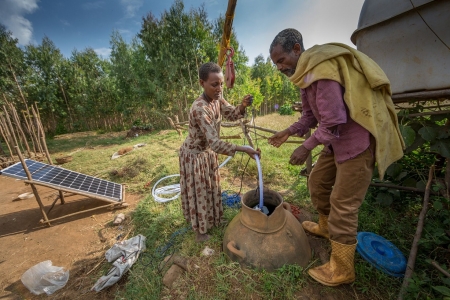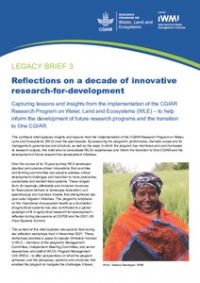As the world struggles to lay out a path to feed its growing population, “Water for Society – Including All” is certainly an aspirational goal. This was the theme for this year’s World Water Week and it is a theme well suited to the current discourse around the 2030 agenda. The opening messages were stark. It was a clarion call that time is running out, and that our food, environment and equity futures are all bound by our choices on water, and particularly on agricultural water.
“Climate Change is Water Change,” Torgny Holmgren, Stockholm International Water Institute (SIWI) executive director said. “We have two options: give into the gloom and doom or be encouraged with the determination to find solutions.”
Dr. Jackie King, this year’s Stockholm Water Prize Laureate was also vocal; “We have the methods, concepts and technology, but not the momentum to get to SDG 6,” which calls for clean water and sanitation for all people.
If we cannot make progress on SDG 6, then achievements key in other SDGs, such as zero hunger and no poverty will fall short, leaving the poorest behind. In short, water runs through everything. But we need to do more now to understand and address these interlinkages if sustainability and inclusion are to be achieved. Three key considerations discussed at World Water Week help shed light on these interlinkages.
Nutrition: It’s time to bridge the water divide
“Globally, one in three people are malnourished, while every third person lives in a water stressed environment—in just three decades one in two people might well be malnourished, while half of the world’s population will live with water stress,” says Stineke Oenema, Coordinator for United Nations Standing Committee on Nutrition (UNSCN), speaking at a session focusing on connecting the water-nutrition divide.
These statistics are worrying, and very revealing – food and nutrition security depend on sufficient availability of water for agriculture, domestic water supply, sanitation and the environment, and water security can only be achieved if we improve our food systems and consider the environmental impacts of diets in the global North.
Most of the world’s water withdrawals are used to produce food. But there are still significant knowledge gaps, not only in understanding the linkages between water and nutrition security, but also how they link with climate change, water pollution, and watershed degradation. Clearly, interventions need to be linked.
“Considering the current water and nutrition challenges, we are not on track to achieve Goals 2 and 6,” says Stineke Oenema, referring to the zero hunger and the water goals. “And we can’t get there unless we explicitly take nutrition into account in water policy.”
What’s leading to this mismatch? “Climate change, population growth, growing wealth, overeating and food losses and waste… all lead to wasteful water use,” says Jan Lundqvist, senior scientific advisor at SIWI.
But all is not lost, and there are ways forward. “Several actions can be implemented now,” says Claudia Ringler, of International Food Policy Research Institute (IFPRI) and program lead at the CGIAR Research Program on Water, Land and Ecosystems (WLE). “These include: 1) Increasing coordination across the water and nutrition communities at all levels to avoid [] nutrition strategies [that] harm water ecosystems, or [] food security strategies [that] convert wetlands to waste areas; 2) Ensuring the nutrition-sensitivity of all water investments; 3) Making dietary guidelines work for people and the planet; and 4) Enabling women’s empowerment through individual and joint water and nutrition interventions.”
Unless a conscious effort is made to integrate this thinking into programs, addressing the linkages between SDGs 2 and 6 may still be far off. But we see progress. Irrigation and water decision makers can now pilot and adapt the recently launched guidance and indicators for monitoring of nutrition-sensitive irrigation and water resource management. Practitioners can also use evidence on the impact of irrigation on undernutrition generated by the USAID-supported Feed-the-Future Laboratory on Small-Scale Irrigation.
Water and nutrition communities are slowly coming closer together. “We can work towards harmonizing the two UN decades of action on nutrition and water by working together [and] developing nutrition-sensitive water management, supporting sustainable and healthy diets and integrating social and gender dimensions in our interventions,” says Stineke Oenema.
Resilience: groundwater could be the hidden key
When Cape Town, South Africa, recently faced a major water crisis, there was no Caped Crusader to save the day. Instead, groundwater along with other integrated solutions, came to the rescue. Because groundwater was still relatively underdeveloped, it helped push back Day Zero.
“Groundwater is a lifeline for communities,” says Karen Villholth of IWMI/WLE and GRIPP, speaking at the session on SDG trade-offs and synergies. “and how we manage our groundwater could be the key to resilience and sustainable development.”
Nearly 99% of all unfrozen fresh water in the world is groundwater, and it can boost production, support incomes and contribute to food security. But groundwater is a finite and relatively slowly renewable resource that is heavily abstracted and polluted. If poorly managed, it can greatly impact ecosystems and societies in food insecure regions as well as in large cities.
According to the UN World Water Development Report 2015, 2.5 billion people depend on groundwater for their daily needs, while 43% of all water used for irrigation is groundwater. Groundwater also sustains baseflows of rivers and aquatic ecosystems. WLE’s study on groundwater and resilience finds that an estimated 14% to 17% of food produced with groundwater relies on unsustainable withdrawals.
These facts emphasize why groundwater is increasingly being recognized, as evidenced by the large number of sessions with explicit attention to groundwater at Stockholm World Water Week. Despite this, groundwater is not fully recognized in the SDGs and not fully accounted for in terms of its critical linkage with sustainable development, especially in its relationship to climate resilience and food security. Understanding those linkages and for example, monitoring levels of groundwater depletion, groundwater pollution and efforts to manage aquifer recharge, could be the crucial tenet to effective management of groundwater resources as well as its proper inclusion in water management policy.
More frequent extreme climate events such as floods and droughts can significantly impact groundwater replenishment. A recent study demonstrates how the El Niño event of 2015-2016 impacted groundwater levels differently in East and Southern Africa. Solutions need to be adopted to help effectively manage groundwater under climate change and how it is used. Farmers as the main stewards of our groundwater resources need to be empowered for enhanced groundwater management.
“Groundwater depletion and flooding will co-exist,” says Villholth, “but innovative solutions to forecast extreme events, to protect and replenish groundwater, and to use it conjunctively with other water sources, build synergies and support us to manage our groundwater, and ensure it retains its strategic role in securing resilience and sustainability as we approach 2030 and beyond.”
Equity: we need everyday water managers
World Water Week’s main theme was about addressing inequalities, and the pivotal role water plays in doing so. And one message resonated very clearly – women, indigenous communities, youth and marginalized communities need to participate and be heard. They are the everyday water managers, and without them, there is no equity.
But equity is also integral to ensuring that solutions stick. Farmer-led irrigation is one such approach, but much needs to be done to scale this up, especially in terms of policy, investment and awareness. “We need to clear misconceptions about farmer-led irrigation,” said Greg Browder of the World Bank. “Farmers are part of the solution; they are change makers and innovators.” But it’s also about making the solutions accessible to them.
Irrigation is a case in point. In May this year, the Ethiopian Government signed a historic tax reform bill that will remove almost all duty tax on irrigation and other technologies. Supported through WLE and IWMI work, this serves as a powerful example of pro-poor policy also working towards food security and environmental goals.
Solutions were also at the heart of the discourse on sanitation, with a focus on the need of increased agency for women, people with disabilities, marginalized communities and migrants. Addressing issues of sanitation also helps address risks to health and the environment caused by wastewater, food waste and human waste. And sanitation solutions make economic and environmental sense. During the week, IWMI and CEWAS launched an online course to promote waste management for environmental benefits, whilst also improving livelihood opportunities. Tools such as this support everyday water managers to be active participants in their community’s sanitation solutions.
Everything is under water
It is very clear that inclusion and equity need to underpin how we think about our food systems, research, policies and decisions. And it is equally important that we also keep water at the fore of the debate. As one speaker noted, water is the blue thread that runs through all the SDGs. As we face increasingly complex challenges, recognizing these interlinkages just might help us find a path for progress for the SDGs.
Thrive blog is a space for independent thought and aims to stimulate discussion among sustainable agriculture researchers and the public. Blogs are facilitated by the CGIAR Research Program on Water, Land and Ecosystems (WLE) but reflect the opinions and information of the authors only and not necessarily those of WLE and its donors or partners. WLE and partners are supported by CGIAR Trust Fund Contributors, including ACIAR, DFID, DGIS, SDC, and others.




/index.jpg?itok=EzuBHOXY&c=feafd7f5ab7d60c363652d23929d0aee)















